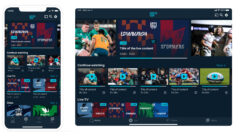Changing TV-Viewing Landscape Brings New Partnerships
Feb 19, 2008 12:00 PM
The days of watching a TV show at its scheduled time may soon be as dated as black-and-white film and variety shows. The one-two punch of DVRs and Internet video are combining to give consumers what they want when they want it, and they’re taking to the concept fast.
The dramatic change in consumer viewing habits, in fact, has played a significant role in the recent writers’ strike, which has largely revolved around how to deal with digital rights for material that’s shuttled from the broadcast to online worlds.
It’s no trivial matter. According to a study by Nielsen Media Research , 25 percent of adults surveyed said they had watched a full-length TV episode streamed online over the past 3 months. The 18- to 34-year-old age group led the pack with 39 percent online viewership. That category of consumer appears to be device-agnostic as well, with 56 percent of those surveyed by Nielsen saying they use DVRs, the Internet, video on demand, and MP3 players to follow TV programs. By contrast, just 21 percent of viewers over the age of 55 use the same media.
Today 22 percent of homes have a DVR, according to Nielsen, up from just 2 percent two years ago. Those include recorders from cable and satellite providers and TiVo. Despite predictions that TiVo would go the way of Replay TV, the former still has legs, thanks to networking capability, portable features, and online partnerships with companies including Yahoo, Rhapsody and Amazon’s Unbox movie-download service.
Partnerships are everywhere. Teaming with the competition, Comcast has launched a high-end DVR service with TiVo offering Boston-area customers TiVo’s WishList, TiVo Suggestions, and Season Pass features for a $2.95 premium. At the same time, Comcast customers get what they’re missing from the TiVo-only experience: on-demand programming. Ease of use remains at the top of consumers’ wish lists for DVR viewing, and Comcast has rolled Comcast services into the TiVo GUI.
And CBS recently announced a pact with TiVo to use the company’s realtime data to help develop the network’s ad clients understanding of DVR users’ behaviors so they can develop content tailored to the new age of viewing.
Supporting the concept of anytime/anywhere viewing, Comcast and Panasonic are working together on a box called AnyPlay that works as a portable DVR. The device records TV programs from a dock that connects to the TV and then separates for use in another room, another home, or on an airplane. The unit has an 8.5-inch screen and doubles as a DVD player.
On the online side, consumer electronics companies are getting into the on-demand side of the business. Sony took its Bravia VideoLink service to the next level this year, announcing at CES a partnership with CBS for network and Showtime content that includes full-length episodes of popular programming, including current and catalog series.
Microsoft’s Media Center will continue to make inroads into the living room as Vista PCs gain marketshare. At the high end, products from Niveus, S1, Exceptional Innovation, and Russound will target the custom channel, where installers can use beefed-up servers to deliver multimedia content to TVs throughout the house. HP has laid claim to the mainstream market with its MediaSmart TVs with built in extenders. The company also announced a set-top box at CES that will turn any TV into a MediaSmart TV.
Despite advertisers’ fears that their messages are lost on viewers who have control over their entertainment, new advertising platforms are expected to thrive in the changing environment, according to industry watchers. Parks Associates forecasts that of the $12.6 billion in ad revenue expected to be generated by 2012, broadband multimedia advertising will account for more than $6.6 billion of the total. Parks says video on demand and DVRs will contribute more than $900 million in revenues for U.S. video service providers.










